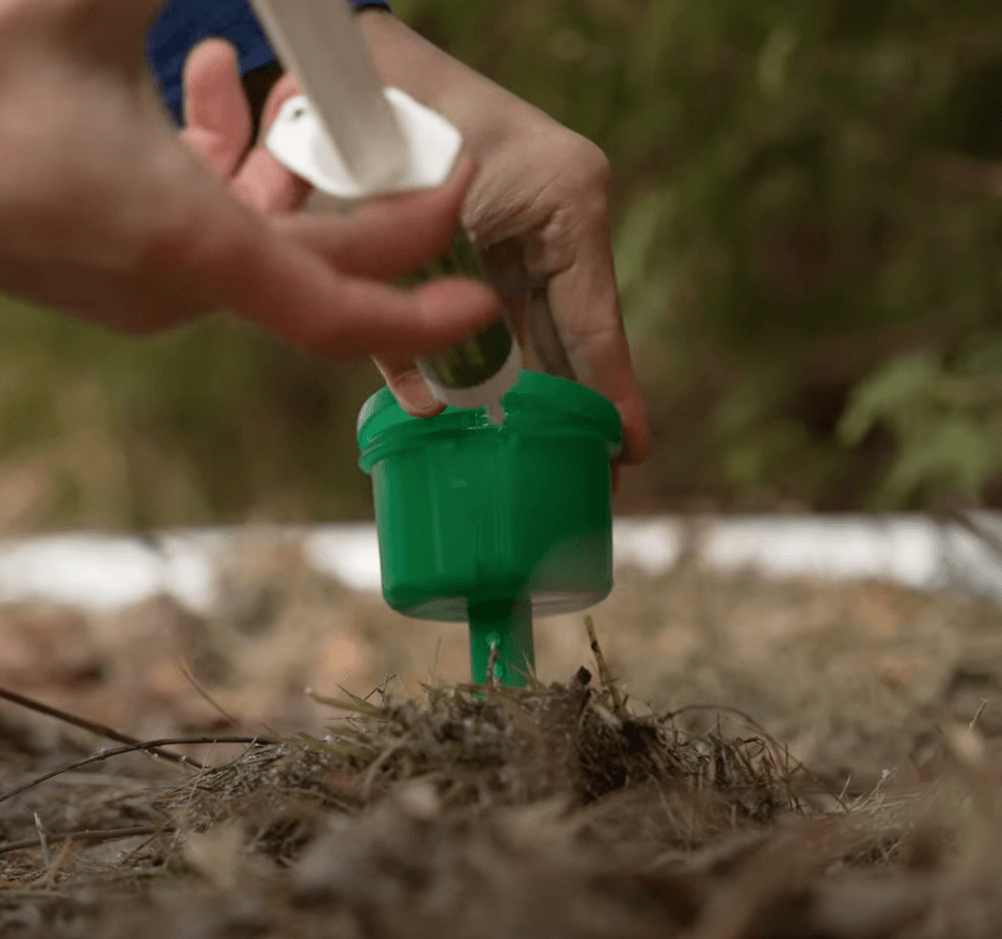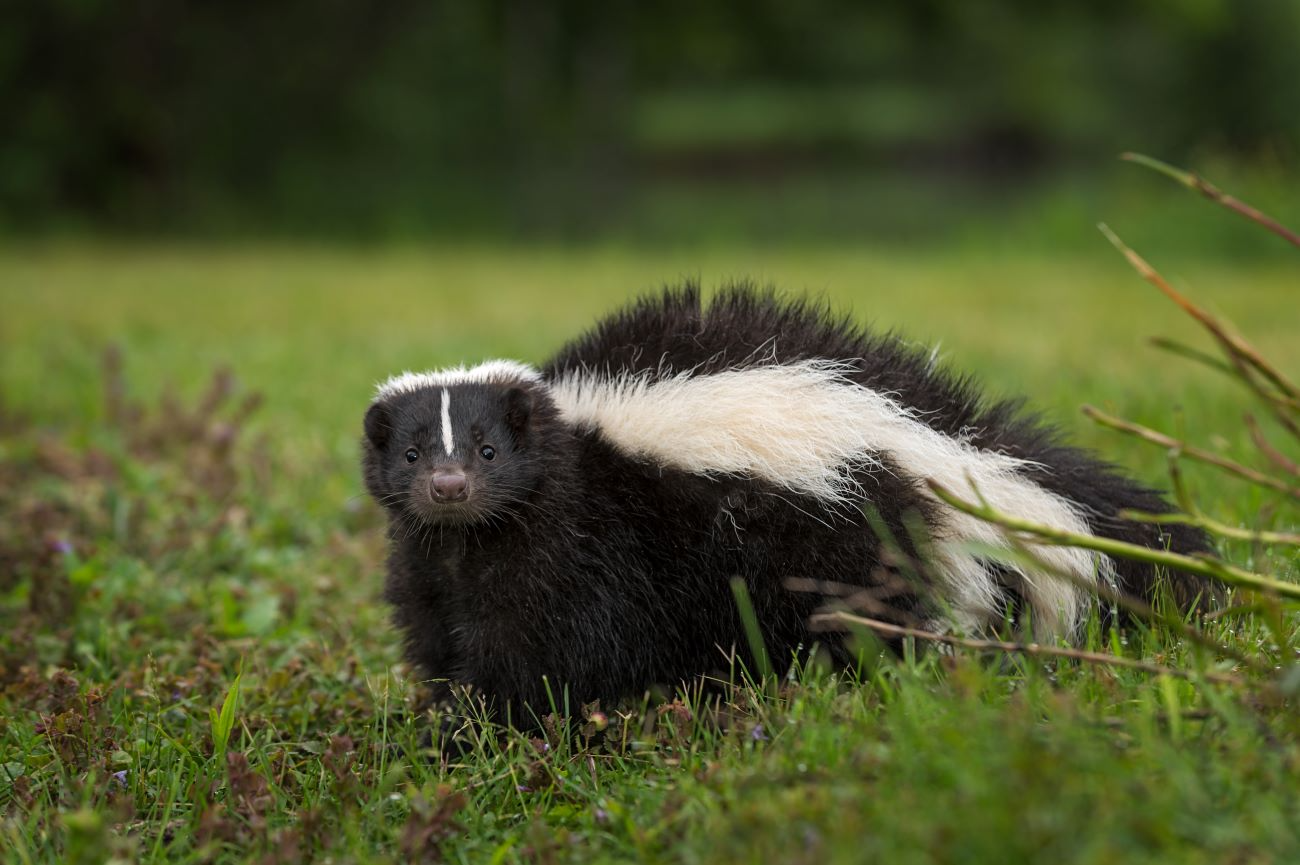
Signs of presence ⌵

General description ⌵

How to get rid of it ⌵

Dangers and damages ⌵
Signs of Skunk Presence
Skunks, with their distinctive black and white coats, leave several visible and olfactory signs that betray their presence around a building. Here's how to recognize these clues so you can act quickly and avoid future problems.
1. Lingering skunk odor
One of the most obvious and well-known signs of skunk presence is the strong, foul odor of their spray, which is used as a defense mechanism. This odor can infiltrate properties if a skunk takes up residence under a deck or shed, or if it has recently sprayed nearby. The odor, which resembles sulfuric gasoline, can linger for several days and becomes stronger in the early or late evening, when they are most active.
2. Cone-shaped holes in the ground
Skunks frequently dig conical holes about 2 to 4 inches deep when searching for insects and grubs in the soil. These small holes, most commonly seen in lawns or gardens, are distinguished by their inverted cone shape, leaving freshly dug soil. By examining your lawn for these regular holes, especially in the morning, you can determine if a skunk is actively feeding in a specific area.
3. Excrement containing insect remains
Skunk droppings often resemble cat droppings, but they usually contain undigested remains of insects, hair, or small bones. You may spot them in areas where skunks feed or near the entrance to their burrows, under buildings, or in secluded areas of the yard.
4. Tracks and claw marks
Skunk tracks typically consist of five toes with claws, visible in soft dirt or dusty surfaces. They have a "staggered" gait where the front and back paws do not exactly overlap, which differentiates them from cat tracks.
5. Burrow entrances and clutter around shelters
Skunks build their dens under decks, sheds, or in natural hollows. The entrance to these dens is often kept clear of debris, as they leave a smooth, open opening for easy entry and exit. Near the entrance, you may also find tufts of black and white fur, a sure sign that they have been there. Their habit of knocking over trash cans or digging through compost can also cause visible damage if they have access to these food sources.
General description of the skunk
Skunks, which are members of the family Mephitidae , are medium-sized mammals, recognizable by their distinctive black and white fur, which varies from striped to spotted patterns depending on the species. About 12 species of skunks are distributed throughout the Americas, including the widespread striped skunk ( Mephitis mephitis ). Most skunks are 20 to 32 inches (50 to 80 cm) long, including their tails, and weigh 5 to 13 pounds (2.5 to 6 kg). Their powerful front legs are adapted for digging, allowing them to forage for food in the ground or to seek shelter in burrows that they dig themselves or reuse other natural shelters.
Skunks are omnivorous and opportunistic, so their diet varies with the seasons and what is available to them. They consume insects, small mammals, eggs, berries, mushrooms, and sometimes human waste when they live near homes. An odd fact: skunks are immune to snake venom and will sometimes eat venomous snakes, in addition to scavenging in wasp and bee nests, protected by their thick fur.
Known for their unique defenses, skunks have scent glands that can spray an extremely foul-smelling liquid up to 10 feet away. The liquid is a chemical mixture of sulfur compounds designed to deter predators by causing intense irritation and even temporary loss of vision. Before spraying, the skunk will give several warning signs, such as stamping and puffing up its fur. This defense system is so effective that few predators dare to confront a skunk, including large carnivores like bears.
Skunks
How to Get Rid of Skunks: A Professional's Guide
Skunks, with their iconic black and white stripes, are often feared because of their ability to project a foul odor when threatened. While they can be beneficial to the ecosystem by feeding on pests, their presence near our homes is generally not welcome. Here’s a step-by-step guide to help you keep these animals away in a safe, effective, and skunk-friendly way.
1. Understanding skunk behavior
Before taking steps to keep skunks away, it is essential to understand their behavior. Skunks are primarily nocturnal, meaning they are most active at night. They are attracted to easily accessible food sources, such as trash cans, pet food left out, and vegetable gardens.
2. Eliminate skunk attractants
The first step in keeping skunks away is to make your property less attractive to them:
- Secure trash cans : Use pet-proof trash cans with tightly closed lids. If possible, keep trash cans in a garage or shed until trash pickup day.
- Remove Pet Food : Do not leave pet food out, especially at night. This food is a major attraction for skunks looking to snack!
- Clean up the yard : Avoid leaving uncovered compost heaps or wood piles, which can serve as hiding places for skunks.
3. Seal potential entry points
Skunks like to hide under porches, decks, and in sheds. To prevent their access, it is crucial to seal all possible entry points:
- In-ground fencing : Install in-ground fencing around sensitive areas, such as decks or sheds. Bury the fence at least 12 inches deep to prevent skunks from digging underneath.
- Physical barriers : Use wire mesh or netting to block off spaces under outdoor structures. Be sure to secure materials so they cannot be moved.
4. Use natural repellents
There are several natural solutions to deter skunks from settling near your home:
- Pepper Repellents : Mix cayenne pepper with water and spray the solution around areas where you have spotted skunks. Cayenne pepper irritates their sensitive noses and deters them from returning.
- KONK : KONK is a repellent specifically designed to repel wild animals. Apply KONK to sensitive areas that need to be protected to repel skunks that venture onto your property.
5. Install lights and sound emitters
Skunks are nocturnal and prefer dark, quiet environments. Installing motion-sensor lights can deter them from approaching your home. Similarly, high-frequency sound emitters, specifically designed to repel pests, can be effective.
6. Using the Answer Pro Cage
In the event that skunks continue to come to your property, despite several attempts at dissuasion, the Answer Pro cage is an ideal solution for capturing skunks and releasing them safely. It is designed to prevent the skunk from becoming frightened when transporting the cage and activating its defense mechanism. In addition, the design of the cage prevents the skunk from being able to raise its tail completely to water, which provides additional protection for the user. Discreet and effective, you simply place the cage in places where signs of presence have been observed. When a skunk is captured, you must relocate the skunk by releasing it in a wooded area at least 15KM from your home.
7. Call on professionals
If skunks persist despite your efforts, it may be necessary to call in a pest control professional. An expert will be able to capture and relocate the skunks in a humane and legal manner, while also offering additional advice to prevent them from returning.
8. Prevent returns
Once you have successfully kept skunks away, it is important to maintain prevention practices in place. Continue to manage food sources, regularly inspect structures on your property for new potential entry points, and use natural or electronic repellents.
The dangers and damage caused by skunks
Skunks, although generally non-aggressive in behavior, can cause problems when they establish themselves around or under properties. Their presence can cause property damage, odor nuisances, and some health risks.
Material damage
Skunks are natural burrowers, digging holes to look for food, mainly grubs and insects, but also to create shelters. When they take up residence under decks, foundations or sheds, they can destabilize the soil, causing cracks and collapse of structures. Gardens and lawns are also often damaged by their cone-shaped diggings, which can quickly ruin the aesthetics of a well-maintained lawn.
Health risks
Skunks are potential carriers of diseases, including rabies and leptospirosis. Although rare, skunk bites or scratches can transmit these diseases to humans and pets. In addition, their urine and feces can contain pathogens, creating contamination risks in the areas where they live and travel.
Odor nuisance
The most obvious danger from skunks is their foul-smelling spray, a sulfurous secretion they release when threatened. This lingering odor is difficult to eliminate and can linger in the air and on nearby surfaces for days. If a pet is sprayed, they may need special treatment to remove the odor. This odor nuisance can be particularly disturbing if a skunk makes a home near doors or windows.
In residential areas, it is recommended to protect foundations and seal potential shelters to prevent skunks from settling in, thus limiting the risk of nuisance and damage.
With the purchase of a reusable half-mask respirator , get a 10% discount on the 3M vapor cartridge .
Discount code: 6TZJ
de rabais
10%
With the purchase of a Webster Cobweb brush , get a 10% discount on the Webster Cobweb extendable pole .
Discount code: DTSQ
de rabais
30%
With the purchase of a FlowZone backpack sprayer , get a 30% discount on complementary FlowZone products .
Discount code: A29B
de rabais
25%
With the purchase of the Catchmaster Ovi-Planter Ago mosquito trap , get a 25% discount on an Ungava brand mosquito repellent .
Discount code: UH5T
de rabais
25%
With the purchase of the Catchmaster Ovi-Catch Ago mosquito trap, get a 25% discount on an Ungava brand mosquito repellent .
Discount code: UH5T
de rabais
15%
With the purchase of the Envirolights JR fly light trap , get a 15% discount on the Catchmaster Flylight JR sticky panel .
Discount code: ZN7G
Best sellers
-
ProPest, Professional Bait for Mice, Rats, and Other Rodents
Regular price $8.00 USDRegular priceUnit price per -
TOMAHAWK, Cage with One-Way Door for Large Wild Animals 14''X8''X8''
Regular price $78.00 USDRegular priceUnit price per -
AEROKURE Shampoo Removes Skunk Odor
Regular price $6.00 USDRegular priceUnit price per -
ANSWER PRO Catch and Release Skunk, Trap for Skunks and Other Large Wild Animals 30.5"x 8"x 9.5"
Regular price $96.00 USDRegular priceUnit price per
Wild Animal Blog

Find your solution
Do you have a pest in your home but you don't know what solution to use to get rid of it? Just answer a few questions, and you will get your solution.










